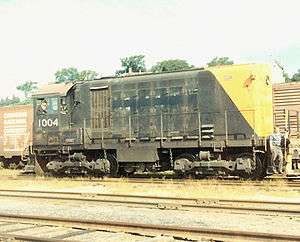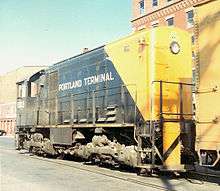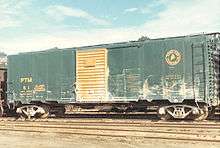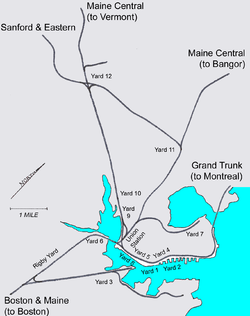Portland Terminal Company
|
Map of the Portland Terminal Company and connecting lines, circa 1960 | |
| Reporting mark | PTM |
|---|---|
| Locale | Maine |
| Dates of operation | 1911–1981 |
| Successor | Guilford Transportation Industries |
| Track gauge | 4 ft 8 1⁄2 in (1,435 mm) standard gauge |
| Headquarters | Portland, Maine |
The Portland Terminal Company (reporting mark PTM) was a terminal railroad notable for its control of switching activity for the Maine Central Railroad (MEC) and Boston & Maine (B&M) railroads in the Maine cities of Portland, South Portland, and Westbrook.
History
The Maine Central Railroad (MEC) came under the control of the Boston & Maine Railroad (B&M) in 1884. The New Haven Railroad secured control of the B&M in 1907, and the Portland Terminal Company was formed in 1911 as part of the New Haven's consolidation of New England transportation facilities. Portland Terminal Company became a subsidiary of MEC while B&M was in financial difficulty in 1914.[1][2][3][4][5]
PTM's activities were vital to Portland's role as a winter seaport receiving Canadian products from the Grand Trunk Railway for export to Europe. Shipping from Portland declined sharply as Canadian exports were routed via the Maritime ports of St. John, New Brunswick and Halifax, Nova Scotia following nationalization of the Grand Trunk in 1923. Exports from Portland declined from 600,000 short tons (536,000 long tons; 544,000 t) per year in the early 1920s to 21,000 short tons (18,700 long tons; 19,100 t) per year during the worst year of the following depression. In the decade following World War II, PTM operated on 40 miles (64 km) of main lines and branch tracks, 84 miles (135 km) of yard tracks, and 18 miles (29 km) of industry-owned tracks. PTM was acquired by Guilford Transportation Industries in 1981,[6][7][8][9][10][11][12][13][14] and continues as a subsidiary of Pan Am Railways.
Geography
Portland occupies an Atlantic coast peninsula between Back Cove to the north and the Fore River estuary to the south. The peninsula is protected from North Atlantic swells by the islands of Casco Bay. Back Cove was too shallow for 20th century ocean commerce. Portland Harbor is the seaward portion of the Fore River estuary.[15]
South Portland occupies the southern shore of the Fore River estuary.
Westbrook is inland of Portland where the pre-railroad Cumberland and Oxford Canal provided transportation for mills using water power of the Presumpscot River.
Grand Trunk Railway from Montreal entered Portland from the north via a long trestle over the mouth of Back Cove. The Grand Trunk yard and wharves occupied the seaward end of the Portland Harbor waterfront along the north shore of the Fore River estuary. This line became the Berlin Subdivision of the Canadian National Railway when the Grand Trunk was nationalized in 1923. Access to the Portland waterfront ended when the Back Cove trestle burned in 1984; and the line to Montreal was sold to a short line operator in 1989.[16][17][18][19][20][21]
Maine Central Railroad Portland Division from Bangor, Maine entered Portland from the north inland of Back Cove.[22]
Maine Central Railroad Mountain Division from St. Johnsbury, Vermont entered Westbrook from the northwest paralleling the old canal along the Presumpscot River. The Mountain Division was abandoned in 1983.[8][12][23][24]
Boston and Maine Railroad Worcester, Nashua and Portland Division from Rochester, New Hampshire entered Westbrook from the west. Boston & Maine discontinued passenger service in 1932 and through-freight service in 1934. The line operated as the Sanford and Eastern Railroad from 1949 until abandonment in 1961.[25][26][27][28]
Boston and Maine Railroad Portland Division Eastern Route from Boston entered South Portland from the south, and was dismantled in 1945.[29]
Boston and Maine Railroad Portland Division Western Route from Boston entered South Portland from the south.

Union Station had eastern and western yards along the Boston to Bangor main line between Rigby Yard and Yard 11. PTM assembled trains in these yards and added mail and express cars to through trains. Following a 1933 joint operating agreement between Maine Central and Boston & Maine, passenger trains from Bangor and points east to Boston or Worcester, Massachusetts and points south ran through Union Station with pooled equipment like the Gull and the Flying Yankee. Other Maine Central and Boston & Maine passenger trains originated or terminated at Union Station. Grand Trunk trains originated or terminated about 2 miles (3.2 km) east of Union Station without using Union Station. Union Station was razed in 1961.[30][31][32][33][34][35][36][37][38][39][40][41][42][43][44][45][46]

Yard 1 served PTM Wharf 1 on the Portland Harbor waterfront along the north shore of the Fore River estuary upstream of Yard 2 and downstream of yard 8. Wharf 1 had water frontage of 1,000 feet (300 m) and included a 100,000-square-foot (9,300 m2) warehouse for handling package cargo interchanged with ships of up to 30-foot (9.1 m) draught.[6]
Yard 2 served Portland Harbor waterfront wharves along the north shore of the Fore River estuary upstream of the Grand Trunk wharves and downstream of Wharf 1. Yard 2 became the local interchange with the Grand Trunk Railway after 1947.[54][55][56][57][58][59]
Yard 3 along the original Boston & Maine eastern route served the South Portland waterfront of the Fore River estuary including PTM Wharf 4, the New England Shipbuilding Corporation and the Portland-Montreal Pipe Line terminal.[60]
Yard 4 team tracks and less-than-carload (LCL) transfer facilities inland of Yard 1 and Yard 2.[61]
Yard 5 car storage inland of Yard 8.[61]
Yard 6 served petroleum bulk plants in South Portland north of Rigby Yard.[37][62]
Yard 7 served distribution warehouses and light industries along the south shore of Back Cove. Yard 7 was the interchange with the Grand Trunk Railway until the Portland Junction connection was severed during construction of a highway bridge over the mouth of Back Cove in 1947.[29][56]

Yard 8 served PTM Wharf 3 on the Portland Harbor waterfront along the north shore of the Fore River estuary upstream of Yard 1. Wharf 3 had water frontage of 1,500 feet (460 m) designed for handling bulk commodities from ships and barges of up to 30-foot (9.1 m) draught. PTM #1601-1800 30-foot USRA hopper cars carried coal from this wharf to local industries. The wharf included a storage shed for 4000 tons of china clay transported to the Westbrook paper mill in PTM box cars. Maine Central 35000-series USRA 50-ton, 40-foot (12 m), single-sheathed box cars were repainted PTM #2001-2150 in 1956. Maine Central 4000-series 40-foot (12 m) steel box cars were repainted PTM #50-54 in 1966. Wharf 3 was closed about 1970. Yard 8 included the first piggyback ramp served by the Maine Central Railroad.[6][47][63][64][65]
Yard 9 was the old Fore River Yard on the Mountain Division adjacent to the north shore of the Fore River estuary upstream of the dredged channel. Rigby Yard was enlarged to eliminate most activity in Yard 9.[66]
Yard 10 served PTM's Thompson Point shops adjacent to the Mountain Division upstream of Yard 9. Thompson Point shops built 49 flat cars, 40 box cars, 3 cabooses, a baggage-RPO and a RPO-smoking car for the 2-foot (0.61 m) gauge Bridgton and Saco River Railroad and Sandy River and Rangeley Lakes Railroad between 1912 and 1917.[67][68][69][70][71]
Yard 11 served large grocery distribution warehouses at Deering Junction where the Boston & Maine WN&P division joined the Maine Central main line to Bangor.[72]
Yard 12 served the city of Westbrook including the S. D. Warren Paper Mill. 7,500 carloads originated or terminated in Westbrook in 1973.[73]
Rigby Yard (Yard 13) was built in 1922 at the South Portland junction of the eastern and western routes of Boston & Maine's Portland division. Rigby became the busiest New England rail yard north of Boston as car storage and locomotive servicing facilities were eliminated from older yards in Portland. Maine Central and Boston & Maine freight trains originated or terminated in Rigby Yard. Yard 12 became the interchange point for Sanford and Eastern trains.[11][25][60][74][75][76][77][78]
Blue Rock Quarry was on the Mountain Division between Westbrook and Portland. Bethlehem Steel delivered 70-ton, 40-foot PTM hopper cars #101-150 in 1956 to replace the old USRA hoppers for coal loading. These cars were used for ballast service as heating oil minimized coal demand. Cars #101-122 were fitted with side extensions for off-line wood-chip loading on the Maine Central Railroad.[79]
Locomotives
References
- 470 Railroad Club (1981). Meet the Maine Central. KJ Printing.
- Albert, Dave & Melvin, George F. (1975). New England Diesels. George R. Cockle and Associates. ISBN 0-916160-01-7.
- Cheney, Fred, Faudi, Phil, Hobb, P.T., Melvin, George and Park, Stewart (1987). "All-Time Maine Central Diesel Roster". Extra 2200 South, Issue 86.
- Cook, Preston (1988). Before Guilford. Old Line Graphics.
- Maine Central Railroad (n.d.). Map of the Rail and Water Terminal Facilities at Portland Maine (Map). C.S.Hammond & Co.
- Crittenden, H. Temple (1966). The Maine Scenic Route. McClain Printing.
- Hartley, Scott (1984). New England ALCOs in Twilight. PTJ Publishing. ISBN 0-937658-10-3.
- Hartley, Scott (1989). Guilford - Five Years of Change. Railpace. ISBN 0-9621541-1-3.
- Hastings, Philip R. (1978). Grand Trunk Heritage Steam in New England. Railroad Heritage Press. ISBN 0-931584-03-5.
- Henderson, John (1991). Cabins, Crummies & Hacks Vol: 1 North & East. H&M Productions. ISBN 0-9629037-1-X.
- Holt, Jeff (1986). The Grand Trunk in New England. Railfare. ISBN 0-919130-43-7.
- Johnson, Ron (1985). The Best of Maine Railroads. Portland Litho.
- Johnson, Ron (n.d.). Maine Central R.R. Mountain Division. 470 Railroad Club.
- Jones, Robert C. (1980). Two Feet Between the Rails (Volume II - The Mature Years). Sundance Books.
- Jones, Robert C. (1993). Two Feet to the Lakes. Pacific Fast Mail.
- Jones, Robert Willoughby (1991). Boston and Maine Three Colorful Decades of New England Railroading. Trans-Anglo Books. ISBN 0-87046-101-X.
- Marson, Don & Jennison, Brian (1999). Railroads of the Pine Tree State Volume 1. Four Ways West Publications. ISBN 1-885614-31-4.
- Meade, Edgar T., Jr. (1968). Busted and Still Running. The Stephen Greene Press.
- Melvin, George F. (2007). Trackside Grand Trunk New England Lines with John Ames. Morning Sun Books. ISBN 1-58248-193-8.
- Plant, Jeremy F. & Melvin, George F. (1998). Maine Central in Color Volume 1. Morning Sun Books. ISBN 1-878887-97-1.
- Plant, Jeremy F. & Melvin, George F. (1999). Maine Central in Color Volume 2. Morning Sun Books. ISBN 1-58248-030-3.
- Robertson, Edwin B. (1977). Maine Central Steam Locomotives. Edwin B. Robertson.
- Robertson, Edwin B. (1978). Maine Central Diesel Locomotives. Edwin B. Robertson.
- Robertson, E. B. (1980). Maine Central Railroad Photo Album. Edwin B. Robertson.
- The Secretary of Transportation (1974). Rail Service in the Midwest and Northeast Region. U.S.Government Printing Office.
- Sweetland, David R. (1989). New England Rails 1948-1968. Morning Sun Books. ISBN 0-9619058-4-0.
- Sweetland, David F. & Horsey, Stephen (1994). Northern New England Color Guide to Freight and Passenger Equipment. Morning Sun Books. ISBN 1-878887-36-4.
- Sweetland, David R. (2000). New England's Colorful Railroads Volume 1. Four Ways West Publications. ISBN 1-885614-32-2.
Footnotes
- ↑ Johnson 1985 p.89
- 1 2 Johnson undated p.65
- ↑ Plant & Melvin 1998 p.3
- ↑ Plant & Melvin 1999 pp.3 & 50
- ↑ Marson & Jennison 1999 pp.20 & 22
- 1 2 3 C.S.Hammond & Co. Map
- ↑ Hastings 1978 p.4
- 1 2 Johnson 1985 p.113
- ↑ Holt 1986 p.12
- ↑ Hartley 1989 p.26
- 1 2 Plant & Melvin 1998 p.4
- 1 2 Plant & Melvin 1999 p.5
- ↑ Marson & Jennison 1999 p.31
- ↑ Sweetland 2000 pp.68-70
- 1 2 Sweetland 1989 p.87
- ↑ Holt 1986 pp.8,12,38-39,64-65,72-73,87,89,95,100 & 140-141
- ↑ Melvin 2007 pp.8 & 12-22
- ↑ Marson & Jennison 1999 pp.31-35
- ↑ Sweetland 1989 p.86 & 90
- ↑ Johnson 1985 pp.12-13 & 115
- ↑ Albert & Melvin 1975 p.56
- ↑ Marson & Jennison 1999 p.9
- ↑ Hartley 1989 p.33
- ↑ Plant & Melvin 1998 pp.3-4
- 1 2 Albert & Melvin 1975 p.63
- 1 2 Plant & Melvin 1998 p.15
- ↑ Johnson 1985 pp.111-112
- ↑ Marson & Jennison 1999 pp.7 & 36-37
- 1 2 Johnson 1985 p.112
- ↑ Albert & Melvin 1975 pp.6,40,56-58,61 & 153
- ↑ Plant & Melvin 1999 pp.4,8-11,24-25,29,56-58 & 60
- ↑ Melvin 2007 pp.10-11
- ↑ Robertson 1977 pp.48-49 & 85
- ↑ Robertson 1978 pp.64-65 & 92
- ↑ Robertson 1980 pp.4,11,29,35,53,60 & 63
- ↑ Hastings 1978 p.5
- 1 2 470 Railroad Club 1981 p.1
- ↑ Hartley 1984 p.31
- ↑ Johnson 1985 pp.12,111-112,125,127 & 134
- ↑ Johnson undated p.267
- ↑ Holt 1986 pp.102-103,108 & 123
- ↑ Sweetland 1989 pp.1,3,79,91-92,108-111 & 116-117
- ↑ Sweetland & Horsley 1994 pp.77,79 & 83
- ↑ Sweetland 2000 pp.11 & 75
- ↑ Jones 1991 pp.82-84 & 89
- ↑ Marson & Jennison 1999 pp.48-49,75 & 77
- 1 2 Albert & Melvin 1975 p.58
- ↑ Robertson 1978 p.82
- 1 2 Robertson 1980 p.5
- ↑ Hartley 1984 pp.25 & 33
- ↑ Sweetland 1989 pp.6 & 77
- 1 2 3 4 5 6 Sweetland 2000 p.76
- 1 2 3 Marson & Jennison 1999 p.48
- ↑ Hartley 1984 p.50
- ↑ Cook 1988 p.108
- 1 2 3 4 Plant & Melvin 1998 p.14
- ↑ Plant & Melvin 1999 p.54
- ↑ Marson & Jennison 1999 pp.32 & 48
- 1 2 470 Railroad Club 1981 p.10
- 1 2 3 Plant & Melvin 1999 p.50
- 1 2 3 Plant & Melvin 1999 p.55
- ↑ Plant & Melvin 1999 pp.52 & 54
- ↑ Plant & Melvin 1999 p.53
- ↑ Hartley 1984 p.28
- ↑ Sweetland & Horsley 1994 pp.7 & 42
- ↑ Johnson undated p.269
- ↑ Crittenden 1966 pp.199 & 201
- ↑ Meade 1968 p.56
- ↑ Jones 1980 pp.355,363,375 & 387
- ↑ Jones 1993 pp.83 & 222-223
- ↑ Plant & Melvin 1999 p.56
- 1 2 470 Railroad Club 1981 p.9
- ↑ The Secretary of Transportation 1974.
- ↑ Marson & Jennison 1999 pp.1,7,19-21 & 37
- ↑ Robertson 1980 pp.28 & 38-39
- ↑ 470 Railroad Club 1981 pp.5-8
- ↑ Hartley 1984 pp.32 & 34
- ↑ Johnson 1985 p.125
- ↑ Sweetland & Horsley 1994 pp.47 & 52
- ↑ Robertson 1977 pp.57,64 & 65
- 1 2 3 4 5 6 7 8 9 10 Robertson 1977 p.61
- ↑ Robertson 1977 pp.60 & 61
- ↑ Robertson 1980 p.49
- 1 2 3 Robertson 1977 p.63
- ↑ Robertson 1977 p.92
- 1 2 3 4 5 Plant & Melvin 1999 p.11
- 1 2 Johnson 1985 p.126
- ↑ Robertson 1977 p.62
- ↑ Robertson 1977 pp.6 & 65
- 1 2 Robertson 1977 p.65
- 1 2 3 4 5 6 7 8 9 10 11 12 13 14 15 16 17 18 Cheney, et al. p.23
- 1 2 3 4 5 Robertson 1978 p.81
- ↑ Albert & Melvin 1975 pp.6 & 59
- ↑ Plant & Melvin 1999 pp.8 & 51
- 1 2 Marson & Jennison 1999 p.49
- ↑ Robertson 1978 pp.81 & 82
- 1 2 3 Albert & Melvin 1975 p.6
- ↑ Plant & Melvin 1999 pp.8 & 54
- ↑ Albert & Melvin 1975 pp.6 & 58
- ↑ Plant & Melvin 1998 p.11
- ↑ Plant & Melvin 1999 pp.8 & 53
- ↑ 470 Railroad Club 1981 p.7
- 1 2 Hartley 1984 p.5
- ↑ Plant & Melvin 1999 pp.8-9
- ↑ Jones 1991 p.91
- ↑ Cook 1988 p.106
- ↑ Albert & Melvin 1975 pp.7 & 61
- ↑ Plant & Melvin 1999 pp.53 & 56
- ↑ Robertson 1978 pp.81 & 83
- ↑ Hartley 1984 p.35
- 1 2 3 4 5 6 7 Albert & Melvin 1975 p.8
- ↑ Robertson 1980 p.23
- ↑ Hartley 1984 pp.28,34 & 67
- ↑ Plant & Melvin 1999 pp.50 & 55
- 1 2 3 Albert & Melvin 1975 p.7
- ↑ Sweetland 1989 p.92
- ↑ Hartley 1984 pp.35 & 66
- ↑ Robertson 1978 p.86
- ↑ Robertson 1978 p.87
- ↑ Hartley 1984 pp.34,64 & 67
- ↑ Plant & Melvin 1998 pp.15-16
- 1 2 Marson & Jennison 1999 p.22
- 1 2 Cook 1988 p.107
- ↑ Plant & Melvin 1999 p.51
- ↑ Hartley 1984 p.34
- 1 2 Hartley 1984 p.66
- ↑ Robertson 1978 pp.85 & 89
- ↑ Hartley 1984 pp.32,35,64 & 66
- 1 2 3 4 5 Plant & Melvin 1998 p.5
- 1 2 Johnson undated p.191
- 1 2 Robertson 1978 pp.85 & 88-89
- ↑ Hartley 1984 p.67
- ↑ Sweetland 1989 p.84 & 94-95
- ↑ Albert & Melvin 1975 pp.8,60 & 133
- ↑ Robertson 1978 pp.49 & 52
- 1 2 Hartley 1984 p.33
- 1 2 Cook 1988 p.127
- ↑ Robertson 1978 pp.66 & 69
- ↑ Hartley 1984 pp.31 & 33
- ↑ Albert & Melvin 1975 pp.9 & 60
- ↑ Sweetland 1989 p.93
- ↑ Sweetland 2000 p.83
- ↑ Plant & Melvin 1999 p.74
- ↑ Cook 1988 pp.87 & 127
- ↑ Hartley 1989 pp.100 & 108
- ↑ Robertson 1978 pp.85 & 90-91
- ↑ Cook 1988 pp.108-109
